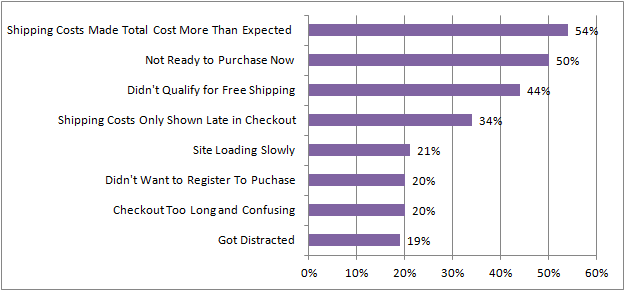If you sell anything on your website, you need to treat it like a real store. After all, it is a real store. It generates real money, and real people buy things from it.

It’s just online.
However, while many marketers may paint online stores and traditional brick and mortar stores with a different brush, they are a lot more similar than you might think when you take a closer look at them.
The challenges of ecommerce are still the same as traditional storefronts. You need to have a solid customer acquisition strategy, meet your conversion rate goals, and focus on website optimization strategies that will provide your customers with the memorable shopping experience.
Online Presence Is Just As Important As A Physical Presence
For starters, online shopping and ecommerce is a multi-billion dollar industry and is expected to grow by 20% this year to $ 1.5 trillion globally. If this is not enough to get your attention, I don’t know what will.
Consumer behaviour also dictates the necessity of having a strong online presence. One of the first things people will do when they want to buy something is check things out online, regardless if they are planning on actually making the purchase online or in a physical store.
“How much time do your customers actually spend online these days? The amount is staggering. According to Google, 97 per cent of consumers search for local businesses online. Your customers are online and you should be too,” says Alex Holden in The Importance of Having a Rich Online Presence. This is a staggering number that proves an online presence needs to be part of your customer acquisition strategy, even if you are only a local mom-and-pop shop.
Duct Tape Marketing provides some additional statistics that make the case for investing in your online presence to improve ecommerce conversions:
- 70% of consumers preferred to do retail shopping online.
- 89% of consumers use search engines to research a product, service or business before making a purchase decision.
For many companies, the reality is that their only presence is online. Even if you have a physical store, a strong and prominent online presence is a must if you want to drive traffic to your store. However, the truth is than most companies are missing out on sales and new business because they do not have a strong online presence.
According to Blur Group, 71% of business websites have an ineffective online presence, 80% are incompatible with popular search engines, 71% are not mobile ready, and a whopping 95% have no shopping cart functionality.
95%! This is where website optimization becomes more important than ever.
Why You Need To Treat Your Website Like A Real Store
You need to treat your website like a real store because that is exactly what it is, and the similarities are very apparent.
“Run your business online as you run your business offline. The level of time, thought, care and development that goes into your brick and mortar business should also go into your website. This is what customers want you to do, and this is what search engines want you to do,” says Mark Walters from SEOmark.
“You wouldn’t give a store/office a strange name (domain), open it in a location that no one can find (rankings), fit it out cheaply (web design), get unprofessional, unknowledgeable employees to work there (content) and not market it (links and social media). Don’t make those mistakes with your website either,” he adds.
Walters’ observations draw an important comparison for people failing to see the connection between the two. Website optimization is very similar to optimizing the effectiveness of a retail store:

What Not To Do – Poor Online Experiences That Will Send Your Customers Running
These elements all add up to the same thing—you are creating a shopping experience for your customers, and they want a memorable experience whether they walk into your store or visit your website.
According to Selz.com, “80% of the online population has purchased something using the Internet; 50% of the online population have purchased more than once.”
Treating your website like a real store is an integral piece of your online customer acquisition strategy. The last thing you want to do is frustrate a user into abandoning the whole shopping process over something that could have been avoided. In real stores, you can ask for help right away, see what you’re buying, and browse for as long as you want, so you’ll want your online store to mimic that ease.
Why do people abandon their shopping carts?
There are countless ways you could lose a customer, and this is why it’s so important to get your website optimization right to meet your ecommerce conversion targets.
You don’t have the luxury to quickly right a wrong like you do when you have a customer in your store, right in front of your face. Considering that many companies exist entirely online, you need to create a great online shopping experience for your users—one that will not get in the way of them making a purchase.
We all know what a good online shopping experience looks like. Fantastic ecommerce websites are easy to find, have intuitive and simple to use navigation, provide you with detailed product/service information, and they make checkout quick and easy.
But what about the challenges of ecommerce that we face, perhaps if we don’t have a huge budget to optimize everything at once?
Here are five things that will immediately turn away customers and cause you to miss out on sales:
#1 – Failing To Provide Breezy Registration
People don’t like to sign up for new accounts, especially when they want to buy something. 11% of US adults have abandoned an online purchase because they didn’t want to register or because the site was asking for too much information, says Forrester. You need to make user registration a breeze by making sign up forms visible, short and simple, and cut out unnecessary steps such as email validation and difficult password requirements. Finally, give them options such as guest sign in or social login to complete their purchases.

“If you have to include other pages, try to make them as quick and easy to fill out as possible. Combine pages if you can, and use two-column layouts for certain sections (like putting billing and shipping information next to each other) to make pages appear shorter,” says Cameron Chapman.
#2 – Failing To Establish Credibility
 People still have a natural distrust for websites and buying online, so expect that users are going to check you out for security. 46% of users read reviews and blogs before purchasing online, and 84% of online shoppers refer to at least one social media site for recommendations before shopping online, as stated in 40 Amazing Online Shopping and Ecommerce Statistics.
People still have a natural distrust for websites and buying online, so expect that users are going to check you out for security. 46% of users read reviews and blogs before purchasing online, and 84% of online shoppers refer to at least one social media site for recommendations before shopping online, as stated in 40 Amazing Online Shopping and Ecommerce Statistics.
According to a study by Actual Insights, more than 75% of users responded that trust logos affect your sense of trust for a specific website, and more than 60% have NOT purchased because trust logos were missing.


Include trustmarks, testimonials, and other information that will lend some credibility to your brand.
#3- Poor Shopping Cart Experience
If your shopping cart sucks, so will your ecommerce conversion rates. Nike does a great job of making the shopping cart experience straightforward.

“Nike’s checkout screen includes all the usual best practices: item photos displayed throughout the process, total order amount, security seals, customer service/live chat, and clear, easily visible buttons. As you enter your information, helpful tooltips let you know if you’re missing something. The details you submit are dynamically validated before the site will let you continue to the next step, helping to cut back considerably on form errors,” says Sherice Jacob.
Statista reaffirms the importance of investing in a strong shopping cart solution. They outlined more than a few important factors you need to consider when developing your online shopping experience:

#4 – Lack Of Customer Service Options
Your online customers are going to have questions and are going to want to contact you about your products. Make this as simple as possible by giving them multiple options. Even if a user doesn’t need to contact you, knowing they have options and you offer a number of ways to do so is reassuring.
Consider:
- Posting an FAQ section.
- Making your contact information visible.
- Providing links to your return policy.
- Offering support through social media.
- Developing a ticketing system for customer inquiries.
- Having a page explaining your customer service policy.
Ikea does a great job of this:

#5 – Lack Of Product Information
When shopping in a real store, you can physically see the product, hold it in your hand, and even try it out. It’s a little different when shopping online; and to supplement this experience, you need to give users as much information about your products and services as possible. According to Biz Report, 42% of users have abandoned an online purchase because of lack of product information.
The NBA Store does a good job of providing users with the information they are looking for:
They provide users with an engaging product description, product image and view option, shipping information, quick access to customer reviews as well as related items they may find interesting. It’s this information that will help users make more informed decisions and have confidence in their purchase.
What do you expect from a website when shopping online? Whether good or bad, intuitive or difficult, the success of your ecommerce website optimization strategy all depends on your knowledge of your customer’s needs, wants and expectations.
Conclusion
Your website is a real store, and you need to treat it as such. The challenges of ecommerce sites are real and complex, but if handled properly, can mean the difference for your bottom line. If you can’t overcome that, you will have poor ecommerce conversion rates and lose out on sales, and you will miss out on the opportunity to turn those online customers into brand ambassadors.
Online shoppers are already skeptical, so don’t give them any more reason to disengage, abandon their shopping cart and choose an alternative option. Focus on proper website optimization, and develop a strong online customer acquisition strategy so you can take advantage of the ever-growing ecommerce market.
Got any tips that we’ve missed? Share them in the comments!
(372)









